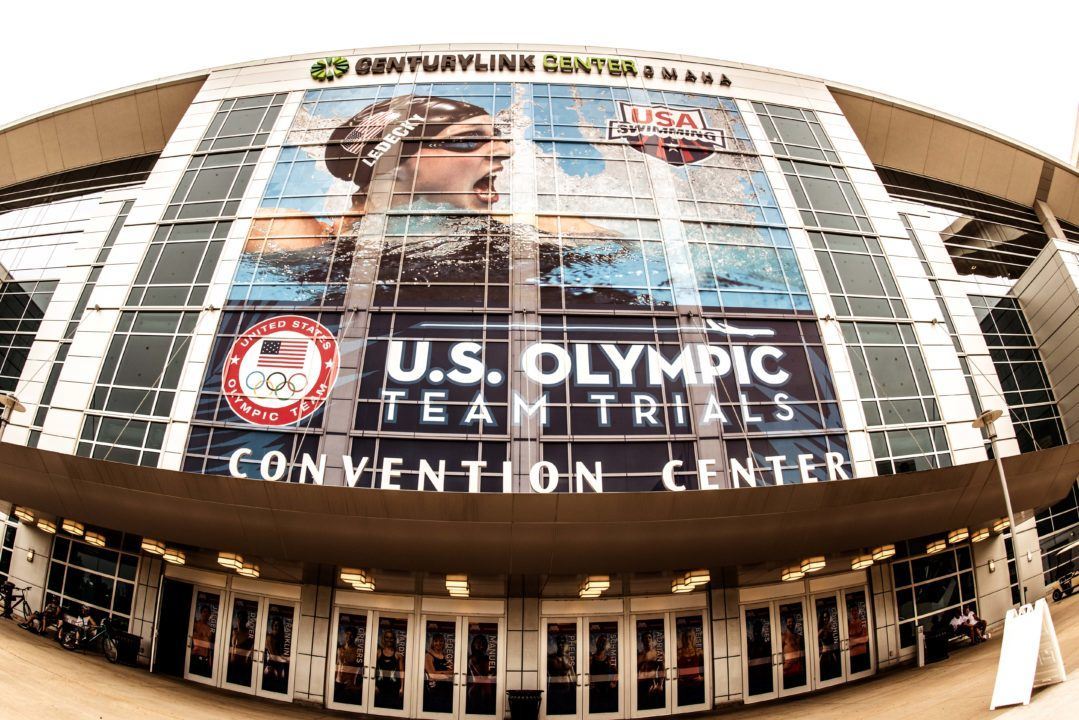2016 U.S. OLYMPIC TRIALS
- Sunday, June 26 – Sunday, July 3, 2016
- CenturyLink Center, Omaha, Nebraska
- SwimSwam Preview Links and Schedule
- Psych Sheets
- NBC Broadcast Schedule
- Friday Prelims Heat Sheets
- Live Results via Commit Swimming App (or find them here. )
- Links to Live Stream
The day 6 prelims are complete, and the field lagged a little behind 2012 in dropping time. On the whole the two meets have been very similar, so this isn’t too significant.
Here’s the field’s time change from seed vs 2012 (positive % is slower):
| 2016 | 2012 | ||||
| Median Time Change | % Who Went Faster | # Faster | Median Time Change | % Who Went Faster | |
| Men 50 Free | 1.0% | 16% | 27 | 0.6% | 25% |
| Women 800 Free | 1.3% | 9% | 7 | 1.4% | 14% |
| Men 100 Fly | 0.9% | 26% | 34 | 0.5% | 37% |
| Women 200 Back | 1.3% | 14% | 19 | 1.4% | 17% |
The morning’s biggest drops belonged to Luke Pechmann in the 50 free at -2.5% and for the women, Megan Moroney in the 200 back at -2.1%. Neither made it back to semis. The most significant was Andrew Liang who dropped over a full second to move from 45th on the psych sheet to an 8th seed in semifinals (he was seeded 42nd after scratches and DQ’s).
| Event | Name | Time Change | Seed | Prelim Time |
| Men 50 Free | Luke Pechmann | -2.5% | 23.18 | 22.59 |
| Women 800 Free | Erica Sullivan | -1.1% | 8:44.63 | 8:38.94 |
| Men 100 Fly | Andrew Liang | -2.4% | 53.94 | 52.65 |
| Women 200 Back | Megan Moroney | -2.1% | 2:15.99 | 2:13.12 |
Slow prelims=fast semis
For most swimmers, going slower than their seed time in the prelims, isn’t a goal. However for top contenders attempting to make the team, conserving energy through the rounds is important. For swimmers who manage to qualify for semifinals, there is a correlation between how much slower than seed they went in prelims and how much faster than their prelim time they go in semis.


A couple points jump off those charts for dropping significant time in both prelims and semis
| Seed Time | Prelim Time | Change | Semi Time | Change | Final Seed | ||
| Abrahm DeVine | 200 IM | 2:02.74 | 2:01.51 | -1.0% | 1:59.43 | -1.7% | 5 |
| Bethany Galat | 200 Breast | 2:29.42 | 2:26.72 | -1.8% | 2:25.25 | -1.0% | 4 |
Neither swimmer has competed in their final yet, so it will be interesting to see how they perform.
Going slower/faster in semis does not have the same correlation in finals. Presumably this is because finals are much harder to qualify for, so comparing two consecutive all out swims is very different to comparing a controlled effort and an all out swim.



Andrew “machine” Mering, your work is impressive. You must see numbers everywhere when you have finished. 🙂
For olympic games it would be nice if you could analyze for each American qualified how they perform compared to their trials times. I know I repeat that times don’t matter at olympic games but it would be interesting to see who improves his times the most and who underperforms the most, in resume who has peaked at the right time.
Go Drew!!!